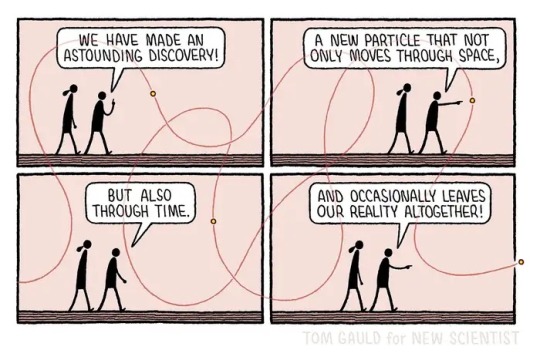#physics of particles
Explore tagged Tumblr posts
Text
youtube
#education#academia#classroom#Proton breaking machine#₹40 lakh crore machine#Large Hadron Collider#CERN machine#most expensive science machine#particle accelerator explained#what breaks a proton#science behind proton smashing#physics of particles#quantum physics explained#how the LHC works#proton smash experiment#biggest machine in the world#science facts 2025#crazy science discoveries#advanced physics technology#breaking atoms explained#insane science machine#mind blowing physics#Youtube
2 notes
·
View notes
Text

My latest cartoon for New Scientist
9K notes
·
View notes
Text
physics professors are really going through it- every day, I think about my quantum physics professor who once went on a rant about how there's too many types of mustard these days followed by the words "well, at least quantum physics is less complicated than the mustard aisle" followed by one of the most cursed derivations I have ever seen
#i think this is professors in general tbh#you apparently have to go a little bonkers to be in academia#i have so many stories#one of my professors once played jeopardy music while waiting for an answer to a class exercise#truly wild#physics#academia#university#college#astrophysics#for anyone that is interested in what we were working on#i believe it was the schrödinger equation for the free particle#not the worst but Bruh#me when scattering states
3K notes
·
View notes
Text

158 notes
·
View notes
Text
OMG Particle

The Oh-My-God Particle was a cosmic ray detected OTD in 1991 and the most energetic one ever observed. It's thought to have likely been a proton travelling at 99.99999999999999999999951% of the speed of light, which is gargantuan even by cosmic ray standards. The reason for what made it travel so quickly is unknown. Must've been a wild event!
230 notes
·
View notes
Text

177 notes
·
View notes
Text
Scientists have made a satisfying and intriguing physics discovery some 16 years after it was first predicted to be a possibility: a quasiparticle (a group of particles behaving as one) that only has an effective mass when moving in one direction. In physics, mass generally refers to a property of particles that relates to things like their energy and resistance to movement. Yet not all mass is built the same – some describes the energy of a particle at rest, for example, while mass may also take into account the energy of a particle's motion. In this case, the effective mass describes the quasiparticle's response to forces, which varies depending on whether the movement through the material is up and down, or back and forth. Whereas regular quasiparticles have the same mass no matter what their direction of travel, the semi-Dirac fermion (to give it its technical name) being studied here doesn't seem to play by the normal rules.
Continue Reading.
163 notes
·
View notes
Text

Attracted to the Core
#particle physics#system#black and white#attraction#artists on tumblr#circles#dots#core#visuals#loop#seamless#trapcode#particular#after effects#motion#daily#evasion
97 notes
·
View notes
Text
#Proton breaking machine#₹40 lakh crore machine#Large Hadron Collider#CERN machine#most expensive science machine#particle accelerator explained#what breaks a proton#science behind proton smashing#physics of particles#quantum physics explained#how the LHC works#proton smash experiment#biggest machine in the world#science facts 2025#crazy science discoveries#advanced physics technology#breaking atoms explained#insane science machine#mind blowing physics
0 notes
Text

My latest cartoon for New Scientist.
8K notes
·
View notes
Text

[6/8/24] i got a result for my calculations,,,, but at what cost? Mathematica was being mean to me so i ended up graphing it on desmos instead which told me that my code wasn’t wrong,,,, i just didn’t expect the results! anyway, idk what to tell my prof bc i got this far without having the faintest clue abt what quantum mechanics is!
i did find a cool new study nook in one of my favourite buildings tho. might abandon my office in its favour
#physics#min vs college#studyblr#college#min vs summer24#study aesthetic#particle physics#physics studyblr
268 notes
·
View notes
Text

500 notes
·
View notes
Text
We used to think it was all particles, but then we looked under the particles and y'know what's down there? Fields. All kinds of fields I never even heard of.
#yall this physics shit is complicated#i like dirt#the particles are way bigger and they don't just disappear usually
137 notes
·
View notes
Text

Ugh they are always doing this
57 notes
·
View notes
Text
"Motion, used correctly, can be more powerful than sheer strength"
"Force and strength work counter to the motion of the world. The universe has its own speeds you need to align with"
"You can never force the motion of the universe to bend to your will"
"We must force the progress we need! Force the world to work the way you want it to!"
One of these teachings is not like the other...
#the ninja and ras don't just fight physically#they actually have ideological differences#and ras has a point#red particles in arin's spinjitzu#he also spins the opposite direction#subtle detail but it makes it look closer to shatterspin#shatterspin is a corrupted form of spinjitzu based on strength#so it makes sense#“I do feel like sometimes life is just dragging me along”#vs finding your place in its current#ninjago#ninjago dragons rising#ninjago dr s2#ninjago arin#ninjago frak#ninjago rontu#ninjago egalt#ninjago ras#ninjago spoilers
168 notes
·
View notes
Text
Bigger Particles Slide Farther

Mudslides and avalanches typically carry debris of many shapes and sizes. To understand how debris size affects flows like these, researchers use simplified, laboratory-scale experiments like this one. (Video and image credit: S. Burnett et al.) Read the full article
#2024gofm#flow visualization#fluid dynamics#gravity current#particle suspension#physics#science#suspension#viscous flow
61 notes
·
View notes